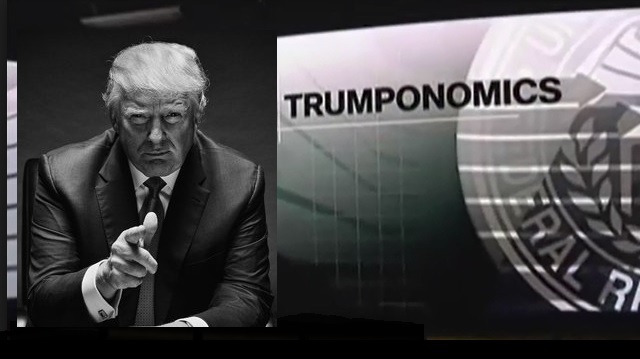The
Truth Behind His Economic Lies
By David Cay Johnston, DCReport
Editor-in-Chief
 There’s good economic news, Donald Trump declared July 27, with
the economy growing 4.1% in the second quarter of 2018. That number is
accurate, for the moment, provided you don’t look beneath the surface or back
at past economic performance or to a horizon about 60 days out.
There’s good economic news, Donald Trump declared July 27, with
the economy growing 4.1% in the second quarter of 2018. That number is
accurate, for the moment, provided you don’t look beneath the surface or back
at past economic performance or to a horizon about 60 days out.
Let’s take a look at the results of Trumponomics at 19 months by
examining Trump’s statements about the facts on economic growth.
That 4.1% growth in the economy, or Gross Domestic Product as
its formally known, is the best so far under Trump. But initial quarterly
reports are notoriously inaccurate. Maybe growth was more and maybe it was much
less.
“The first-to-final estimates of quarterly GDP lately has had a
lot of volatility,” noted Professor Robert Eyler, chair of the economics
department at Sonoma State University in California. He said the revised data
may show just 3.5% growth, which would still be a good number.
Facts are never enough for Trump, who has to exaggerate even
when he has good news. So we get this from
the Embellisher in Chief: “We’ve accomplished an economic turnaround of
historic proportions.”
Nope. Not even close.
Obama did better in four of the 32 quarters he was in office. So
did every other president back to Harry S Truman.
The GDP growth champ was Jimmy Carter with 16.4% real growth–four times Trump’s best–back in 1978, as the graphic accompanying this article shows. The red line in the graphic marks 4.1% over the last 71 years so you can appreciate how unreliable Trump’s remarks were.
The important takeaway from the chart above—notice that real
economic growth was often above 4.1% until the start of the Age of Reagan in
1981. That’s about when real wages stopped growing for the bottom 90% of
Americans.
The long-term decline in wages tracks with the decline of union
membership. Reagan, the only union president ever to become president, worked
hard to weaken unions.
Trump wants to get rid of them.
Trump wants to get rid of them.
Trump also declared that the economic growth was not a one-time
blip. “These numbers are very, very sustainable,” Trump said, reading uneasily
from a prepared text and stumbling over some economic concepts. “It’s not a
one-time shot.”
Trump’s best turns out, in good part, to be an artifact of his
trade war with China. In the second quarter, America experienced a massive
spike in sales of soybeans. Sales and purchases of other products also soared
as “business stockpiled inventory ahead of the impending
import duties,” according to a
Reuters survey of economists.
Soybean prices in late July stood at $8.72 a bushel, half their June 2012 peak of $17.375. That’s before adjusting for inflation, which would make
the 2012 price more than $19 per bushel.
No wonder Trump wants $12 billion of welfare for soybean farmers
in areas that favored him in the 2016 election because he promised to put their
interests first.
If he doesn’t reach into your pocket to give money to those farmers they may be out with pitchforks and many of them certainly will not reward him again at the ballot box.
If he doesn’t reach into your pocket to give money to those farmers they may be out with pitchforks and many of them certainly will not reward him again at the ballot box.
That soybean welfare, by the way, works out to about $37 per
American, assuming it lasts just one year.
Back out the one-time boost in economic growth from soybeans and
some other hurried up exports and Professor Eyler may well be right that
routine revisions will show growth was actually about 3.5% and the 4.1% rate
will not be replicated this year.
American farmers grow about 119 million bushels of soybeans,
nearly a third of which had been going to China. Brazil produces almost as much
of the versatile crop.
Since Trump announced his trade war with China the price of Brazilian soybeans has soared as Beijing orders from our Latin American competitor, punishing the farmers who backed Trump.
Since Trump announced his trade war with China the price of Brazilian soybeans has soared as Beijing orders from our Latin American competitor, punishing the farmers who backed Trump.
“As the trade deals come in one by one, we’re going to go a lot
higher than these numbers,” Trump said.
Only time will tell, but it’s not wise to count soybean profits
before the harvest.
China had been spending about $20 billion a year on American
agricultural products—with soybeans accounting for nearly two-thirds of those
sales. Add Canada and Mexico, two more countries where Trump has called for
economic warfare, and Trump has put at risk almost $60 billion worth of farm exports, 42% of the
total of American farm sales
overseas.
China and Mexico, by the way, account for half or more of
American exports of pork, poultry, dairy products, cattle hides, sorghum and
soybeans, though only soybeans involve billions of dollars.
“We have accomplished an economic turnaround of historic
proportions,” Trump also said outside the White House.
When Trump assumed office the economy was growing steadily, not
collapsing.
July will mark 94 consecutive months of growth in the number of
American jobs–of which only 19 months will be on Trump’s watch. Let’s hope the
number of jobs keeps growing, but let’s not get dragged into the ahistorical
nonsense that Trump inherited economic disaster in 2017.
That was Obama. When he took office in 2009, the country was
losing up to 750,000 jobs each month. But when he left the nation had added
more than 15 million jobs from the low point.